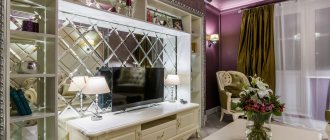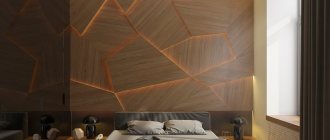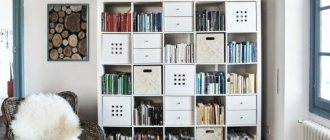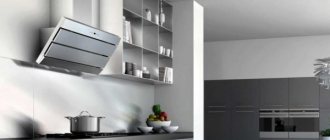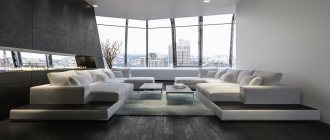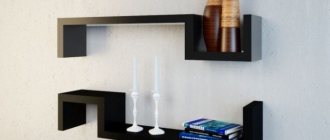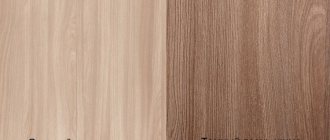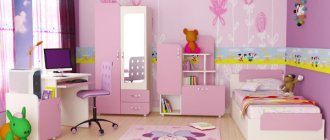The self-leveling floor has high mechanical strength and resistance to chemical and aggressive external environments, which allows it to be used in many rooms. The duration of operation depends on the correct implementation of preparatory work, compliance with installation requirements and the quality of the mixture.
Glossy self-leveling floor in the kitchen
White self-leveling floor in the living room
Classification of self-leveling floors
To obtain a high-quality floor covering, 2 layers of self-leveling floors are usually used:
- the main one, which smoothes out all unevenness and is made up to 8 cm thick;
- finishing, which determines the appearance of the flooring in the room.
Decorative self-leveling floor
In some cases, linoleum, parquet boards or similar floor coverings are placed on the base layer instead of the finishing coating.
When choosing a floor covering, you should pay attention to the composition of the included components.
According to this criterion, mineral mixtures are distinguished, which are used for the most part for the main layer, and polymer mixtures, which ensure the creation of the top layer.
3D self-leveling floor with design
Glossy gray kitchen floor
In turn, polymer coatings are:
- polyurethane, which, depending on the structure, are divided into thin-layer and highly filled;
- methyl methacrylate, the most resistant to overload and aggressive external environment;
- epoxy, with brittleness and increased moisture resistance.
Mineral self-leveling floor red
Self-leveling floor in the living room of a country house
How to fill a decorative floor with a pattern yourself
Tools and devices for work
If you plan to fill the decorative floor yourself, you need to take care of the necessary tools and devices for ease of work.
- To prepare two-component mixtures, you will need a construction mixer, which can be an electric drill with an appropriate attachment.
- A squeegee is a tool similar in appearance to a wide notched trowel, but differs in the presence of a long handle and the ability to adjust the gap, which determines the thickness of the fill layer. A squeegee is used to distribute and level the mixture over the surface of the base.
Specific tools for working with self-leveling polymer floors
- The needle roller is also involved in distributing the composition over the surface. It is used for rolling the poured floor - this helps to free the distributed composition from air bubbles.
- Rollers with fur attachments, with a pile of no more than 12÷15 mm, are used for rolling the primer mixture over the surface.
- Soft brushes 120÷150 mm wide for distributing compounds in hard-to-reach areas. You will need several of these, since epoxy compounds make them literally disposable.
- Spatulas width from 100 to 400 mm. You cannot do without this tool when performing any work related to the application and distribution of building compounds. For example, it is not always and not always convenient to work with a squeegee, and then a spatula of the size required for a particular case comes into the process.
- Paint shoes are a kind of studded sandals that allow the master to easily reach any place on an already filled surface without causing damage to it. The marks left by the thorns on the poured compound heal on their own.
- Container for soaking and cleaning tools.
- A vacuum cleaner, preferably a construction one, is necessary, since before each stage of work a thorough cleaning of the surface is required.
- Work clothes, rubber gloves, devices for respiratory protection - this can be a mask or a respirator.
- Polyethylene film to protect the walls and floor of the room where the compositions will be mixed.
- Food stretch film. Some builders wrap this material on clothes (sleeves, trouser legs) or shoes to protect against epoxy mixtures, which cannot be washed or cleaned after hardening.
- Wide masking tape is useful for protecting the lower part of the walls of the room where the self-leveling floor is being installed from mixtures.
The process of pouring a floor with a pattern - step by step
Due to the fact that each manufacturer has certain requirements for the base on which the decorative coating will be poured, before starting work, you must carefully study the instructions. Thus, some compositions can be laid on a base with any moisture content, while others can only be laid on a thoroughly dried surface. The durability of the decorative floor will depend on this factor, so the manufacturer’s recommendations should not be ignored.
| Illustration | Brief description of the operations performed |
| So, before starting work, the moisture content of the concrete base is controlled using a moisture meter. Most often, the manufacturer specifies a maximum threshold that does not exceed 4%. If the floors have been leveled recently, then at least 21 days must pass from the moment the screed was installed. If you pour the composition onto an undried surface, then after it hardens the coating may begin to peel off. Of course, not everyone has a moisture meter. You can also get by with the “folk” method of checking - spread a square sheet of polyethylene (approximately 1000x1000 mm) on a concrete floor and stick it around the edges with tape. If the next day drops of condensation or evaporation are visible on the film, then the base has not yet dried to the required conditions. | |
| If the humidity meets the requirements, you can begin to work. The first step is grinding the concrete base. This process is necessary to open the pores of concrete for better penetration of the primer composition into them. Professional craftsmen carry out this work using a special grinding machine. | |
| If you will be installing the self-leveling floor yourself, then you can use a hand-held sander for sanding, installing an abrasive attachment on it - a “cup”. | |
| After grinding, the surface must be thoroughly cleaned of concrete dust with the utmost care. For this purpose, an industrial or regular powerful vacuum cleaner is used. In any case, cleaning must be done several times, and special attention must be paid to the corners and joints of vertical and horizontal surfaces. | |
| Next comes mixing the two-component primer mixture. When performing this process, it is very important to comply with the proportions specified by the material manufacturer, otherwise the soil will not have all the declared qualities. Mixing is done using an electric drill, on which a special mixer attachment is pre-installed. | |
| The next stage of work is applying a primer mixture to the sanded and dust-free concrete. To do this, the primer is usually poured onto the base in a small puddle, and then distributed over it using a wide spatula or a roller with a fur attachment. | |
| The work must be done carefully, trying not to touch the lower part of the walls. The best option would be to temporarily seal this area of the vertical surface with masking tape, which is removed only upon completion of the work. | |
| All of the above work can be done in one day. The primed surface is left to dry for a day - during this time the composition will penetrate into the pores and strengthen the structure of the concrete. In addition, after this layer dries, surface flaws - unevenness and cracks - will clearly appear. | |
| On the second day, when the primer has absorbed and dried, the base is inspected to identify irregularities and damage. | |
| The next step is to repair the detected defects. For this purpose, a special two-component repair mixture is usually used, which is mixed identically to the primer. In order to repair individual damage, the composition is applied only to the necessary areas. As an alternative to a special repair compound, many craftsmen use a primer or base filling compound, mixing it with pure quartz sand to the desired consistency. | |
| If it is necessary to correct the evenness of the floor, then the repair solution is applied to the entire surface and distributed using a squeegee or wide spatula, and then passed over the floor with a needle roller. If a material of the same color is used for priming and repair, then the master must be very careful and ensure that the entire mixture is distributed in an even layer over the entire surface. | |
| Depending on the choice of composition for repairing the floor, it may be white, gray or brown. The repaired surface is left to dry for another day. | |
| When the repair composition has dried, the surface must be sanded, freeing it from small irregularities and hardenings, which can interfere with good adhesion of the layers. The work can be done manually, using a grater or a grinding machine with an abrasive attachment installed on it. After sanding, the floors must be cleaned of any dust that has formed. First use a vacuum cleaner and then a damp cloth for cleaning. Wet cleaning must be done several times. There should not be any, even small debris, hair on the surface, as well as other fragments that could interfere with high-quality filling. | |
| For the next stage of work, you need to put paint shoes on your feet, and in order not to completely ruin your work shoes, it is recommended to wrap them with stretch film. Paint shoes will allow you to move freely over the entire surface of the floor, including those areas where the composition has already been spilled. | |
| Now you can start mixing the mixture for the bedding layer. In this case, it is necessary to strictly observe all proportions established by the manufacturer, indicated on the packaging or in the attached instructions. | |
| The finished mixture is poured onto the base in puddles and a squeegee is evenly distributed over the surface. Distribution and leveling are carried out with smooth movements. | |
| After the floor area is covered with the composition distributed over the surface, it must be rolled with a needle roller. This will provide additional distribution - self-leveling of the layer, and the release of possible air bubbles. The work is carried out in the same order until the entire surface of the floor is completely covered with this underlying layer. | |
| Already a day after pouring the bedding layer, you can begin working on the floor pattern. The first thing to do is to try on the canvas in the place where it will be fixed. If the drawing is placed on two or more canvases, then they must first be combined in the area where they will be fixed. | |
| You must proceed in the same way if you choose a canvas with a 3D pattern. After trying on the material at its future location, if necessary, excess areas are marked, for example, under a wall projection, and carefully cut off. | |
| Next, the most labor-intensive process begins. The printed canvas must be separated from the backing, which is intended to temporarily protect the adhesive layer. The backing is removed gradually as the film (canvas) with the pattern is glued to the floor surface. In this case, the canvas is smoothed with a special plastic spatula so that there are no air bubbles left underneath, which can blur the decorative effect or simply weaken the finishing surface. | |
| Each craftsman has his own secrets that simplify the separation of the decorative film from the backing, as well as the smoothing of its folds when gluing. For example, to make the film easier to separate from the substrate, it is sometimes heated to a warm state using a regular hairdryer. For better smoothing and removal of air bubbles from under the film, the surface of the film or floor is sprayed with water from a spray bottle. For comparison, a tinting film is glued to glass in approximately the same way. | |
| When the pattern is fixed to the floor surface, the top transparent protective film is removed from it. | |
| In the case when the design is not applied to the general film sheet, but is made using the “pull-out” technique, that is, by cutting out various ornaments from paper of different colors, then each of the elements will have to be adjusted separately, after removing the top protective film. Here it is necessary to clarify that there are different options for installing patterns, so each of them comes with instructions, which must be followed when laying it on the floors. If the decor is made to order, the contractor must provide the product with his own recommendations. | |
| The next step is to prepare the composition for the finishing transparent layer. It is also mixed from two components taken in the proportions specified by the manufacturer. It is recommended to leave the prepared mixture for two to three minutes (so that the air bubbles formed during mixing rise), and only after this can you begin to pour the last, top layer of the self-leveling floor. | |
| The mixture is poured onto both the drawing and the rest of the floor area in puddles, and then evenly distributed over the entire surface of the squeegee. | |
| After 5-10 minutes, depending on the chosen material, the applied layer must be rolled with a needle roller. | |
| If during kneading the finishing mixture turns milky white, don’t be alarmed. After drying and complete polymerization, it should become transparent. The result of the work done is presented in the illustration. |
* * * * * * *
So, from the information presented above it is clearly seen that if you wish and follow all the recommendations of the self-leveling floor manufacturer, it is quite possible to do the work yourself. Moreover, it does not require a complex or irreplaceable tool. By arranging the coating yourself, you can save a significant amount. And this is especially important when funds for repairs are limited. True, when performing such work you will have to mobilize all your accuracy and attention, since it will be extremely difficult to correct the mistakes made.
At the end of the publication, for greater clarity of information, there is a video about pouring a 3D floor with a photo drawing.
Advantages of self-leveling floor
Due to the operational characteristics and installation features, the following advantages of self-leveling floors are distinguished:
- high aesthetic indicators, which are manifested in a wide variety of design solutions, for example, the use of 3-D images;
- mechanical strength, allowing the floor covering to remain intact even after exposure to heavy loads;
- durability, providing up to 15 years of comfortable operation;
- high moisture resistance, allowing the use of self-leveling flooring in the bathroom;
- resistance to ultraviolet radiation, as a result of which the self-leveling floors in the apartment do not fade from exposure to sunlight;
- environmental friendliness, allowing the use of self-leveling floors in a room where there are children or people prone to allergies;
- no odor emission, despite the influence of external factors, for example, heating from an electric heater;
- compliance with fire standards, since all types of self-leveling floors are fire resistant and do not emit harmful substances when burning;
- quick installation, largely depending on the type of mixtures used;
- the ability to complement any room design, for example, by using decorative self-leveling floors;
- seamlessness, as a result of which the floor in the apartment does not allow spilled water to pass down.
Blue stone-look self-leveling floor
Photos of 3D floors
There are many finishing materials for flooring. But it is the poured floors that amaze with their artistic possibilities. 3D poured floors are a full-fledged element of the interior. Sometimes they don’t just decorate, but play a dominant role in the design of an apartment.
Ideas for creating a floor with bright blooming roses, cold arctic ice, and warm sea surf are realized thanks to the technology of poured floors. Such coatings have good durability and will last a long time, decorating your apartment.
Video: Selection of 3D floors
Disadvantages of self-leveling floors
When choosing self-leveling floors for an apartment, you should take into account the possible disadvantages of this floor covering that you will encounter. For example, the cost of flooring, which is especially high when using imported flooring mixtures. Also, you can fill the floor only at a certain humidity, which is quite difficult to control.
Two-color self-leveling floor
When repairing, it is necessary to carry out complex dismantling of the old coating to ensure good adhesion to the base. Scratches may appear as a result of improper filling or operation; glossy self-leveling floor becomes slippery after washing, which is especially dangerous for older people;
Polymer self-leveling floor in the kitchen
In addition, a self-leveling floor with a pattern can become boring or cause difficulties when changing the design.
Matte black self-leveling floor
It is quite difficult to fill a self-leveling floor alone, since the solution quickly hardens and loses its properties, so the work should be done as a team.
Self-leveling marble floor
What are 3D floors
The concept of 3D self-leveling floors means a polymer surface with a three-dimensional pattern of any origin inside. It is made of a transparent, durable top layer 3-6 mm thick; underneath it is any image or other objects (for example, coins, quartz sand), which acquires a spatial optical effect.
Interesting! The picture used is a three-dimensional drawing applied to the base surface with acrylic paints. The second option is to spread banner or vinyl film, which can be ordered from a specialized printing house.
The use of three-dimensional drawings is widely in demand in shopping and entertainment centers and offices. Application in residential premises is still gaining popularity and is not known to everyone.
Basic rules of preliminary preparation
The basis for the self-leveling floor is a concrete slab, cement screed, and ceramic tiles. The floor in a private house is often made of wooden floorboards and the main advantage of self-leveling coatings is the ability to fill without dismantling if the old floor is in good condition and has high strength. At the same time, to prevent the self-leveling floor from leaking through the cracks, you should carefully putty all the holes between the boards.
Self-leveling floor in black and white design
For good adhesion, it is important to carefully remove all traces of oil, glue and other contaminants on the substrate. If possible, it is necessary to eliminate all irregularities on the surface.
Polymer self-leveling floor in the hallway
To improve the adhesion of the polymer to the base, the surface should be primed. Depending on the porosity and absorption rate of the primer, the priming process may need to be repeated.
Zebra pattern self-leveling floor
Installation process
Installation begins with stirring the solution. If this action is performed using a household hammer drill or a household drill, you should be careful. These tools are not designed for constant heavy loads; every 10-15 minutes of operation they must be left alone for half an hour.
First you need to prepare the concrete base, which you have already managed to reach, for priming. The more thoroughly dust and dirt are removed, the better the self-leveling floor will hold up.
It is better to plug holes in the concrete base with a rag. It is possible that they lead into voids in the concrete slab. Not only will most of the solution go into the slab, but it can also block the ventilation of the neighbors below.
Tools used for pouring
To perform the filling you will need the following set of tools:
- Low-speed drill or hammer drill for mixing the solution. It is necessary to ensure that the power of the tool is sufficient and that it does not fail due to overload or overheating. Filling should be carried out continuously in the room, so there will be very little time for the drill to cool down.
- Mixer attachment. It is important to decide in advance whether a drill or hammer drill will be used to mix the solution, since they have a different cartridge. As a result, the stirring attachment from the drill will not fit the hammer drill and vice versa.
- Buckets. The volume of buckets must be at least 20 liters. Do not use dirty buckets, as the filling will be interspersed, which will result in poor performance.
- Putty knife. Although the mixture is called self-leveling, it is better to pre-level it under the radiator and in hard-to-reach places to obtain a better-quality floor covering.
- Needle aeration rollers. The presence of air bubbles significantly reduces the mechanical strength of the self-leveling floor and, as a result, its durability. Therefore, air should be removed by carefully rolling the surface with a roller. For greater convenience, you should choose a roller with a telescopic handle.
- Wet feet. Special shoes with spikes that allow you to walk on a self-leveling floor that has not yet hardened to distribute it evenly over the entire surface and perform other operations.
- Laser level. Most important for large premises or if 3D self-leveling floors are planned.
Features and advantages of the material
A self-leveling floor is a hardened polymer fill that is applied to an image. The technology is reminiscent of making jewelry from epoxy resin or those same epoxy rivers in wooden tabletops. The coating is completely seamless and due to its texture it creates the effect of volume and presence.
The composition of self-leveling floors can be one- or two-component. The first is a regular leveling layer of mortar for further decorative finishing. The second is decorative in itself, and it is two-component floors that we are talking about when we talk about the 3D effect.
The thicker the finishing layer of fill, the more voluminous and expressive the drawing appears. The composition includes resin, a special hardener, and fine quartz sand for strength. The mass is kneaded, poured onto the base and carefully leveled.
3D floors are ordinary self-leveling polymer floors, but with minor nuances. The design is applied with acrylic paints or in the form of ready-made printed vinyl or banner film. Additionally, you can decorate it with a layer of sand, small pebbles, shells or any other inserts.
Self-leveling 3D floors have many advantages, starting with strength, durability and a perfectly smooth surface. The seamless coating is easy to care for - dirt does not get clogged anywhere and water does not accumulate. The polymer coating lasts for decades and does not wear off, hardly scratches or breaks.
Polymer floors are not afraid of moisture and ultraviolet radiation, are resistant to chemical influences and are quite easy to install. Disadvantages include long drying time, specific care, cost and difficulty of dismantling. But all this is fully compensated by the bright, stylish and modern result.
80 living room design ideas in Khrushchev (photo)
Features of floor coverings in rooms with high humidity
Rooms with high humidity include the bathroom and toilet. The self-leveling floor in the bathroom must withstand constant high air humidity, frequent contact with water on the surface, including hot water, it must be easy to clean, but at the same time remain non-slippery; do not allow microbes to multiply quickly, which is especially important for the floor in the toilet.
Choosing a self-leveling floor for a wet room is the most difficult. For example, it is prohibited to use thin-layer polyurethane floors due to their tendency to delaminate when exposed to moisture for a long time.
Black self-leveling floor in the bathroom
The floor in the toilet, made of methyl methacrylate polymer, will have a color limit. In order to depict a pattern or create an exclusive colored self-leveling floor, you should use an epoxy polymer base.
Self-leveling floor with floral pattern
Self-leveling floor in the living room
Priming process
Primer is the application of primer with a brush or roller to a concrete base. It usually takes a minimum of time.
Drying depends on the weather, but even if the air is humid, you can continue working after an hour and a half.
Candle atmosphere: main types of candles for the home- Where can I find a gift?
Schemes for the location of spotlights in the kitchen
Features of self-leveling flooring in the kitchen
The main factors that distinguish self-leveling floors in the kitchen from floor coverings in other rooms are:
- presence of high humidity near the sink;
- drops of fat and oil near the kitchen stove;
- there is a risk of spilling aggressive substances, for example, vinegar essence, which can damage the self-leveling floor in the kitchen;
- increased requirements for hygiene.
Self-leveling floor in Art Deco design
If desired, you can make a white self-leveling floor in the kitchen, but various stains will be too noticeable on it. Therefore, for ease of cleaning in the kitchen, it is recommended to choose a colored self-leveling floor. To create a creative design in the kitchen, a self-leveling marble floor can be used.
Gloss can often be slippery, so it is preferable to choose a slightly rough self-leveling floor in the kitchen to prevent injuries due to falls.
Self-leveling floor in a country house
Self-leveling floor in a country style kitchen interior
Examples of 3D floors in the interior
At the stage of familiarization with 3D flooring technology, the question arises about the appropriateness of their use in residential premises: bedroom, living room, bathroom. The scope of application is much wider than is commonly thought.
Self-leveling 3D floors fit harmoniously into the interior of not only shopping centers and entertainment establishments, but also residential apartments. It should be borne in mind that when choosing an image, you need to pay attention to the style of the room and your own taste preferences. In addition, the designated goals regarding the visual change in the space of the room are also important. For example, reducing or increasing space, zoning a separate area or emphasizing. Stylistic features also include several elements, in particular color shades.
Healthy! Creating a cozy atmosphere is much more useful than following the fashion trends of modern fashion. Therefore, when choosing an image for a 3D floor, be guided by your own preferences, developing an interior in which you will feel comfortable.
Features of self-leveling floor on the balcony
The self-leveling floor on the balcony is most susceptible to external factors. For example, in sunny weather, a black self-leveling floor can heat up to a high temperature, which is impossible in a living room. For this reason, for the floor covering on the balcony, it is important that the linear thermal expansions of the base and the finishing coating coincide.
Glossy self-leveling floor in the bedroom
Self-leveling floor with design in the dining room
Regardless of which self-leveling floor is chosen, compliance with the manufacturer’s requirements, the choice of high-quality materials and tools will allow you to comfortably use the floor covering without flaws for several decades.
Self-leveling floor in a loft interior
Self-leveling floor in the bedroom of a private residence
Video description
About calculating the amount of mixture for a self-leveling floor in the video:
Final calculations
As a rule, provided that the base is well prepared, calculations are made based on the data specified by the manufacturer of the self-leveling floor. As an example, we will give the procedure for calculating the required amount of mixture to fill a layer of 2.5 millimeters. At the same time, the manufacturer indicated that for 1 millimeter, when pouring 1 square meter, 1.5 kilograms of the composition are needed. The calculation requires three steps:
- The area of the filled plane is calculated. With the correct geometry, it is enough to multiply the width of the room by its length. Complex contours are divided into rectangular sectors and their area is summed up.
- The required thickness is determined using a level. In the case of a relatively flat surface, you can use a standard or laser building level. In case of significant deviations in height, it is necessary to use a water level.
- All received data is recorded and double-checked.
Let's assume that the width of the room is 4.7 meters and the length is 5.9 meters. Therefore, the area of the room will be:
As mentioned above, it is planned to pour a layer of 2.5 millimeters at a mixture consumption of 1.5 kilograms per millimeter. So per square meter you will need:
For the entire room:
When calculating, it is necessary to take into account the density of the composition. We provided approximate indicators for this parameter above, but for more accurate calculations you should check the data provided by the manufacturer.
Self-leveling floor with colonial-style ornaments Source polsdelat.ru
What principles should be followed when choosing a material?
When choosing mixtures for filling the floor, it is advisable to be guided by the opinions of experts and give preference to well-known, proven brands. It’s worth remembering: you won’t be able to create a high-quality, durable floor with a cheap mixture.
Romantic Provence
Calm pictures are suitable for a Provencal interior. You can create a green meadow, a flowering meadow, a seashore, a sandy beach.
The best choice would be no pattern. It is more important to create an antique design. Imitate natural stone and worn tiles.
A self-leveling floor made in the kitchen will be a good choice for surface decoration. The option is practical, durable, and interesting in terms of design possibilities. The optimal solution is easy to find to suit every taste and fit different styles.
Unusual loft
The self-leveling floor for the loft is distinguished by its elementary simplicity of design. It is enough to perform the top colorless fill, which will expose the cement insides. You can additionally create the impression of sloppy work. Classic gray can be replaced with black, white or a combination of both.
Occasionally brighter colors are added. Suitable: muted orange, brick red, yellow ocher. It is acceptable to imitate rough wood, brick or stone.
Filled floors for a store or office
By creating poured floors, you can realize the most original design fantasies. An unusual and beautiful poured floor will attract customers to a boutique, store, or exhibition center. Creative and stylish design of the premises will raise the status of the SPA salon, entertainment center, and design studios.
If you notice an error, a non-working video or link, please select a piece of text and press Ctrl+Enter .
0
Design Features
The artistic design of the self-leveling floor always requires special attention. After applying the base layer, it can be decorated:
- plain;
- apply a drawing through a stencil;
- make a pattern with a three-dimensional design printed on vinyl film;
- paste a photo of self-leveling floors for bathtubs;
- apply small decor, buttons, pebbles, snails and other decorations to the same film.
Working with film is more difficult. All air bubbles need to be removed from under it. This process is similar to gluing wallpaper. The main thing in this most important operation of all technology is cleanliness and holding until completely dry.
When applying the finishing layer, ensure that the surface is evenly covered and use a needle roller. You can start walking on the finished floor after 2-3 days.
Traditional minimalism
For a minimalist interior, the best solution would be a calm, monochromatic color. White or gray will fit organically into any environment. Available in matte or moderately glossy light color.
The design must not have an elaborate pattern; uniform, discreet inclusions are acceptable. The fewer elements that catch the eye, the better.
Note!
Linoleum for the kitchen - master classes on installing linoleum in the kitchen interior. The best design ideas and color schemes (120 photos)Illumination of the work area in the kitchen: TOP-130 design options. Rules for selecting and installing lighting in photo reviews
Stretch ceiling in the kitchen - TOP-130 design options for stretch ceiling in the kitchen + photo examples
